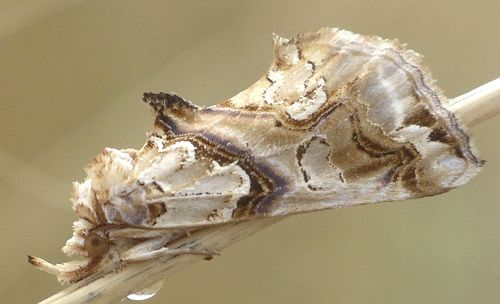by Valerie
April, 2008Moonseed Moth
There are about ten times more moths than butterflies, but they are noticed much less often. The moonseed moth (Plusiodonta compressipalpis) gives a good illustration why this is so. This moth is just a bit over 1/2 inch in length, and it does not look particularly moth-like. As with many nocturnal moths, the moonseed moth spends daylight hours as still as possible, utilizing its cryptic coloration to remain hidden while in plain view. By having all manner of markings and little protrusions, the outline of the insect is disrupted so much that it can usually pass as a bit of leaf, lichen, or tree bark. Up close, these utilitarian markings reveal themselves to be intricate and often very attractive. In this photo, the antennae are not visible because they are tucked under the wings, while the strange things sticking out of the head are the labial palps. The moonseed moth is in the large family Noctuidae. The moth gets its name from the larval food, which consists of plants in the moonseed family (Menispermaceae). The caterpillars are as cryptic as the adults, looking very much like bird droppings. Here in Austin they feed on Carolina snailseed (Cocculus carolinus), a common vine that produces bright red berries in the autumn. |